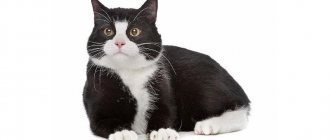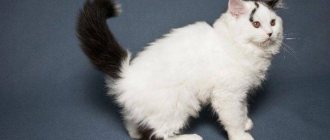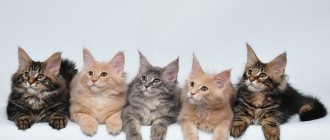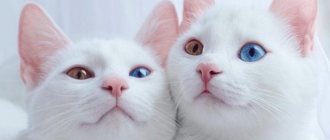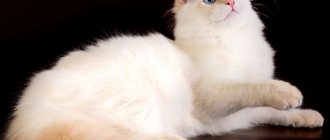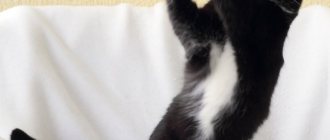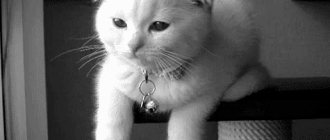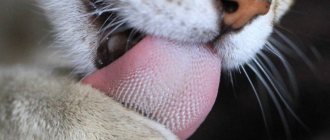Bi-colored kittens with black and white markings are also called tuxedo or piebald cats. Some people mistakenly believe that tuxedo cats are a special breed.
Tuxedo refers to the distinctive markings on the coat that make it look like someone is wearing a formal tuxedo. Mixed breed domestic cats, also called moggies, may also have black and white markings.
Black is a common coat color in cats because it is the dominant gene. Black and white cats have a white spot gene that prevents colored melanocytes from migrating into these areas.
Here are 10 popular types of cats that can have black and white coats, as well as other potential coat colors and markings.
Maine Coon
The Maine Coon is one of the largest cat breeds and is known for its incredible affection. Combined with their distinctive appearance and shiny coat, they are one of the most popular breeds around the world.
Maine Coons are usually tabby, but they come in a variety of colors and patterns, including black and white. These cats usually get along well with all family members, including respectful children and dogs.
They are loyal and affectionate, but not too needy. Maine Coons are known to be expert mousecatchers and may not be suitable for families with small, furry pets.
Bobtails
Also a short-tailed group of cats. As a rule, bobtails are distinguished by their large size and dense, wet-resistant coat.
Tails can be of the following forms:
- Stump. From 2 to 5 cm. There are breaks at an obtuse angle.
- Spiral. The apparent length is 5–10 cm. There are numerous fractures, often at sharp angles.
- Retracted bobtail. Near the base the tail is normal, after 5–7 vertebrae kinks begin.
- Panicle. Length from 5 to 15 cm, breaks at right angles.
Bobtail breeds
There are several breeds of bobtails.
American
The head is wedge-shaped. The body is moderately long, the back is straight. Weight 3–8 kg. The coat can be short or semi-long.
Yankeebobs with semi-long hair should have a collar
Japanese
The head is triangular. Individuals with eyes of different colors are often found. The body is oblong, muscular, but not massive. Weight 3.5–5 kg. The coat is short.
In Japan, this cat symbolizes friendship, in Korea and China - well-being.
Kuril
The head is in the shape of an equilateral triangle. The body is strong and muscular. Weight 3–7 kg. The coat is semi-long and thick. There may be tufts on the ears, making the animal look very much like a lynx.
Thick, warm fur helped Kurilian Bobtails survive in the wild
Mekong
The head is rounded. The body is rectangular in shape, but quite slender. The only colors allowed are Siamese. Weight 2.5–5 kg.
According to legend, these animals accompanied the princesses, and while they were bathing, they strung jewelry onto the cats' broken tails.
Karelian
The head is triangular, the muzzle is narrow. The body is strong, the hind legs are noticeably longer. The coat can be short or semi-long.
Karelian Bobtail is the rarest variety
Character
Bobtails are conspicuous companions. They love to spend time in human society and are painfully sensitive to loneliness.
The most independent bobtails are the Mekong.
Most of these animals are very active and love outdoor games. They are smart and often have developed logical thinking. Most often they respond well to training. Usually travel easily.
As a rule, they get along peacefully with cats and dogs. Most of all, the “Japanese” love the company of other animals, and they prefer to be friends with representatives of their own breed.
The hunting instinct is pronounced. Many bobtails are excellent rat catchers, and some - for example, Kuril and Japanese - can fish.
Most are quite sociable, often making rich intonation sounds similar to chirping or abrupt yelps, but not to a regular meow.
The quietest and calmest of bobtails are Karelian. If such a cat needs something from its owner, he would rather touch it with his paw than meow.
Moti's character is simply unique. It’s not for nothing that kurbob is called cotops. He chose me as his owner, and it's obvious. He only sits in my arms and follows me around the house. My husband says that he even feels when I should come - he runs to the door. And when I’m not home for a couple of days, the cat... howls. Drawingly, long, like a dog. Despite the fact that both his husband and mother feed him, he keeps them at a distance. Bored, my red “Hachiko” curls up on some of my clothes. I even specially leave him some old things if I’m away for a long time, as an “anti-stress.”
Martovskaya
https://irecommend.ru/content/ne-pakhnet-i-ne-metit-ili-antikvar-v-koshachei-shkure-zabavnye-foto
Care
Short-haired bobtails are usually brushed once a week, while semi-long-haired ones are brushed once every 2-3 days. During the molting period, this is done daily. If necessary, you can bathe the animal approximately once every 2 months.
Video: Kurilian Bobtail - all the details about the breed
Cornish Rex
The black and white Cornish Rex impresses with its famous dense, curly rows of coat; wide set large ears; and a slender physique. They are sometimes called greyhounds from the cat kingdom.
Energetic and sociable, this breed thrives in company. The Cornish Rex is an intelligent cat that can be taught many impressive tricks, some of which can help as therapy animals.
Canaani (Kanaani)
This is a fairly large cat with an athletic build, with a neat head, large, wide-set ears and expressive green (or yellow-green) eyes. The standards allow spotted and marbled patterns in dark brown (almost black), chocolate or cinnamon. Representatives of the breed are descendants of the domestic cat and the Libyan wild cat. These are independent, but playful and intelligent animals, they get along well with their owners, without singling out any of the family members.
Canaan is the pride of Israeli felinology. The breed is named after the famous Israeli land of Canaan, mentioned in the Bible. Selection work began in the 90s of the last century, and for the first time the breed was recognized by the European felinological system WCF in 2008.
Savannah, Chausie and Canaanese are unusual in their origin - they are the result of crossing ordinary domestic cats and representatives of wild felines. It is extremely difficult to breed such a breed: the hybrids of the first generations are few in number and often sterile; there is no guarantee that the desired “wild” traits will be successfully established in the offspring. And you need to constantly purchase exotic animals for breeding work - and this is a lot of money! So it is not surprising that representatives of these breeds are few in number and cost a lot of money, and seeing them at cat shows is a real success.
Manx cat
Like the Cornish Rex, the Manx is dog-like. They are usually playful, sociable, even-tempered and energetic. Manx cats are also intelligent and highly trainable.
This breed is usually tailless, but they sometimes have a short stump. They come in a variety of coat colors, including black and white. This short-haired variety can shed heavily, and with their rounded and shorter back, they may be more susceptible to spinal problems. These cats are also famous for their mousecatching skills.
Longhair
Burmese cat
Burma, as these cats are called for short, has the luxurious fur coat of the Persians and the original color of the Siamese. There are many legends and tales wandering around the breed and they are called “sacred”. It is difficult to say what is true and what is fiction, however, the Burmese are truly distinguished by their “holy” character.
They are playful, but not dirty, active, but in moderation. They do not impose their communication and agree to wait until the owner has time to communicate. The Burmese cat gets along with children, but does not like excessive noise and tense environments.
Neva Masquerade
They are called Siberians with Siamese sophistication; cats and cats of this breed are beautiful, large and very colorful. But this is by no means a merit of the efforts of the breeders, but the result of an accidental love between a Siberian cat and a cat with a Siamese color (it is not known for sure whether she was Siamese or Himalayan).
The Neva cat is a long-liver, its fur does not cause allergies and does not require painstaking care. She has a certain charisma - she loves to show off, but she is distrustful of strangers. Adapts perfectly to new conditions and loves his family.
Norwegian Forest Cat
Once upon a time, this large, colorful animal with long luxurious hair lived in the Norwegian forests. Naturally, this determined his hunting qualities and endurance, but selection work turned the cat into a cute domestic creature that retained high intelligence and beautiful appearance.
The Norwegian Forest cat is suitable for indoor keeping; it is very balanced and calm. He loves to communicate, but sometimes he doesn’t mind being alone. Finds a common language with other pets and is good with children.
Persian cat
Cats of this breed are hard to miss - after all, they have an extravagant appearance - a wide muzzle with a flattened nose and the most luxurious fur. The breed has undergone a number of changes, not always positive, but today it has no flaws, and its representatives are healthy and active.
The Persian cat is an ideal companion that does not like loneliness and is not suited to living on the street - only with a person does it feel calm and confident.
Ragdoll
A young amazing breed of cats that can completely relax all their muscles, which is why its name translates as rag doll. These are quite large animals with beautiful fur. Born with white fur, after a year and a half it acquires the most incredible colors.
Ragdolls are absolutely sociable cats; loneliness is difficult for them, and they are ready to follow their owner anywhere. They are phlegmatic, they love to lie around, but they also don’t mind playing, especially with children.
Siberian cat
This is a native breed of Siberia and is believed to have descended from wild forest cats. Stocky, large (cats weigh up to 12 kg), fluffy - cats of this breed cannot leave anyone indifferent.
The Siberian cat has a developed hunter instinct, therefore, even if it gets lost, the pet will not disappear and will be able to provide itself with food. This quality also helps rid the house of rodents. These pets are unpretentious in all aspects of life, intelligent, but somewhat reserved.
Turkish Angora
The Angora cat is snow-white (blue and black individuals are less common), a graceful beauty - with blue, greenish or different eyes. She is a regular participant in various exhibitions and is popular.
The Turkish Angora does not require special care, it is smart, intelligent, calm, gets along well with children, but can be “on its own” or overly sensitive.
Munchkin
This breed gets its name from its shorter than average legs, which are due to a natural genetic mutation. Munchkins come in a variety of color combinations, including black and white.
Due to their short legs, the Munchkin may need extra help when it comes to grooming hard-to-reach areas. The debate revolves around the ethics of continuing to breed this cat with its abnormal mutation and the potential correlation between specific health problems and this body shape.
Oriental shorthair cat
The Oriental Shorthair is often confused with its Siamese cousin and is therefore a separate breed. Unlike Siamese, these cats have green eyes and come in a variety of colors and patterns, including black and white.
Like the Siamese, the Oriental Shorthair tends to be inquisitive, chatty, and even-tempered. While no cat is truly hypoallergenic, this breed is known to produce less Fel D1 protein, which can cause allergies. They have short, single coats, which means these cats sense the cold and prefer a cozy, draft-free home.
Red devils and timid white angels
No matter how strange it may sound, there is an opinion that the character of a cat is in some mysterious way connected with its color. Moreover, even some breeders and veterinarians think so, that is, people who, by definition, deal with a large number of these same cats.
Table: the estimated character of a cat depending on its color
| Cat color | Character |
| Black and white, gray, black tabby | Stress-resistant, the best possible |
| Calico | Demanding, independent, dedicated |
| White (with blue eyes) | Timid |
| Colorpoint with brown marks | Quite aggressive |
| Ginger | Brash, capricious, vindictive |
| Silver and brown spotted tabby | Nightmarish beyond description |
| Classic brown tabby or mackerel | Affectionate, flexible, playful |
| Blue (tabby or solid) | Friendly, contactable |
Ordinary cat lovers also notice some patterns.
The life of the author of this article at different periods of time was also connected with cats: a chocolate-point Siamese, a black-and-white bicolor of “noble” blood, and a Canadian Sphynx. And this is what the author has to say about this:
- Siamese was pure evil, an absolute misanthrope and an extreme dirty trick; he devoted his entire life to a fiery struggle to reduce the human population in a single apartment (and would still have achieved success if the duration of a cat’s life had not been significantly less than the duration of a human life);
- the black and white mongrel cat had a remarkably affectionate and devoted character and manners of a true gentleman: from the moment when True Love happened in his life, there was no such tasty treat that he would not take to the lady of his heart;
— the sphinx is a completely different story; It was this animal that cared so sincerely and openly about its owners that it did not consider it necessary to reveal its character to them at all.
However, even having two matches with the table out of three possible, the author will refrain from generalizations, since he is absolutely sure that assessing the character of a cat by its color is as futile as assessing the mental abilities of a woman by the color of her hair.
Persian cat
While the pure white Persian is often the most photographed and highly prized variety of this popular breed, they also come in other colors, including black and white.
There is no mistaking this breed for their long, thick coat; large bright eyes; and crumpled faces. Their popularity also stems from their laid-back, low-energy, and cozy nature.
They are not known as one of the smartest or most trainable cats. The Persian's long, shiny coat requires daily grooming. It tangles easily and causes discomfort if neglected.
Scottish fold cat
Known for its small, curled ears, the Scottish Fold looks quite mischievous. These cats are usually not mischievous at all.
Known for being laid-back and friendly, Scottish Folds typically do well around other pets and respectful children.
This breed is at greater risk of developing degenerative joint disease, which can affect the development of cartilage and bones.
Their thick coat requires regular grooming to avoid problems with fur balls. The black and white combination is just one of the many colors the breed can have.
Siberian cat
Siberian cats have a very thick, semi-long-haired, triple-haired coat. They need this fur to survive in the frosty forested subarctic regions of Siberia. The breed is growing in popularity due to its affectionate, playful nature and striking appearance. Siberians are active and smart and need communication so as not to get bored.
Their coat is not prone to tangling, but sheds heavily every two years. The brown tabby is the most common pattern of Siberians, although they come in a variety of colors and patterns, including black and white.
Origin of dwarf breeds
The efforts of breeders are aimed exclusively at improving the bright appearance. There is no point in training cats to catch mice, since this is not what their future owners will buy them for. Over the past 30 years, a stereotype has developed that a domestic cat should be a small, cute, eternal kitten, even at a conscious age. Numerous catteries in America and Europe began to diligently develop a selection of beautiful miniature cats that would delight their owners with a cheerful and playful character until old age.
Little-studied and fairly young breeds have a number of disadvantages:
- instability of crossing results (it is not always possible to obtain a kitten that fully meets the breed standards);
- paucity of material on genetic pathologies;
- limited gene pool.
Nevertheless, small cat breeds are actively developing and, for sure, breeders will be able to achieve good results in the near future. American specialists do this best, and today there are about 15 species of mini-cats that are the result of a gene mutation or hybrids of several breeds. The only type of miniature cat that has not undergone major genetic changes is the Singapore breed.
Turkish Angora
The elegant, long-haired Turkish Angora was once associated only with white skin color. They are still most often found in this color and come in many other variations, including black and white.
Turkish Angoras are generally best suited to family homes, where they spend most of the day. Sociable and affectionate, they need a lot of attention and enrichment.
They are more active than regular cats and can become mischievous if they get bored. Unlike most cats, this breed often loves to swim and play in the water.
